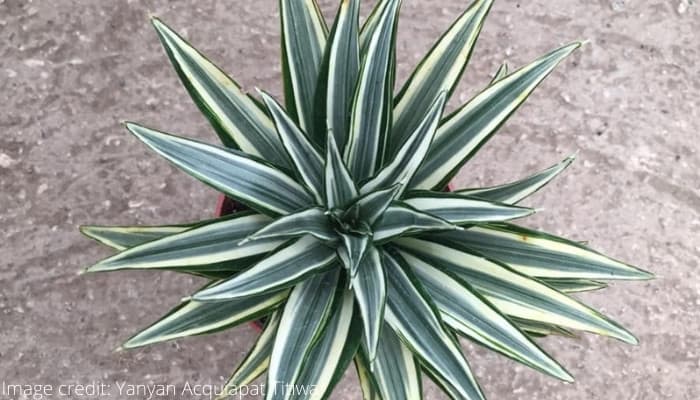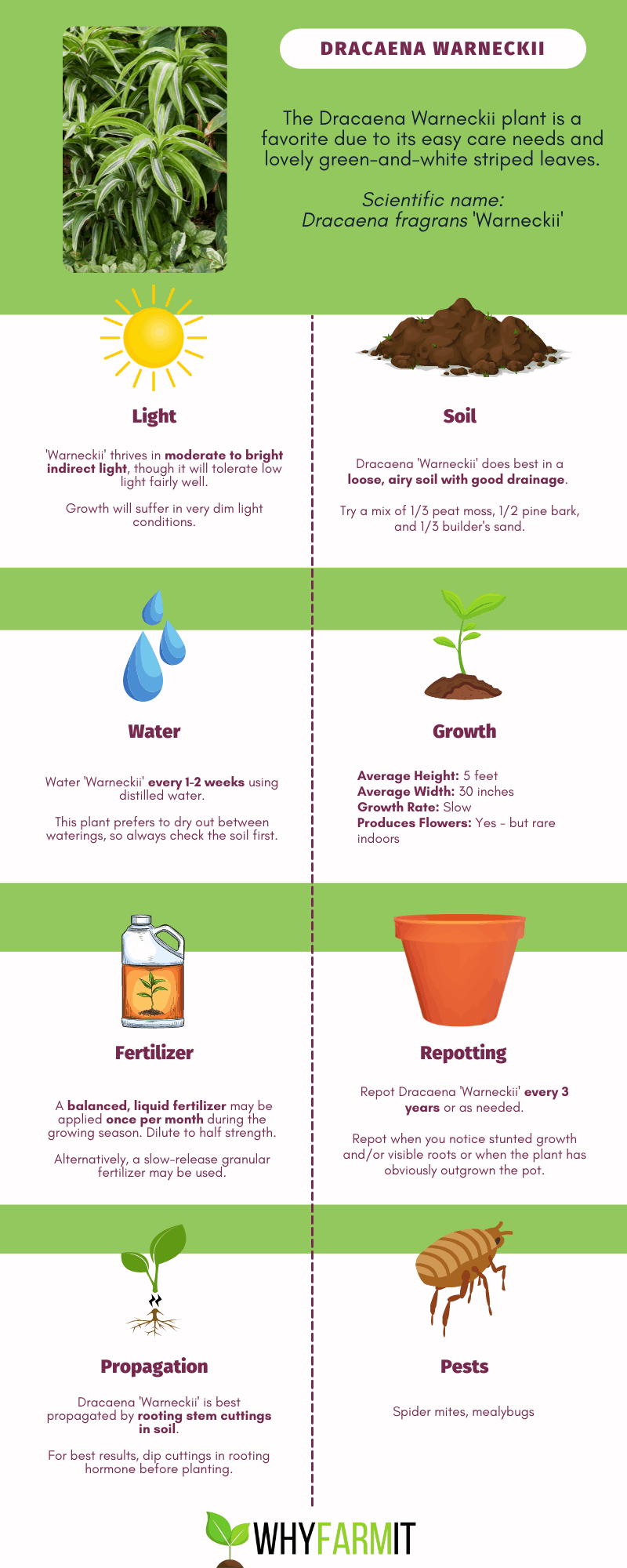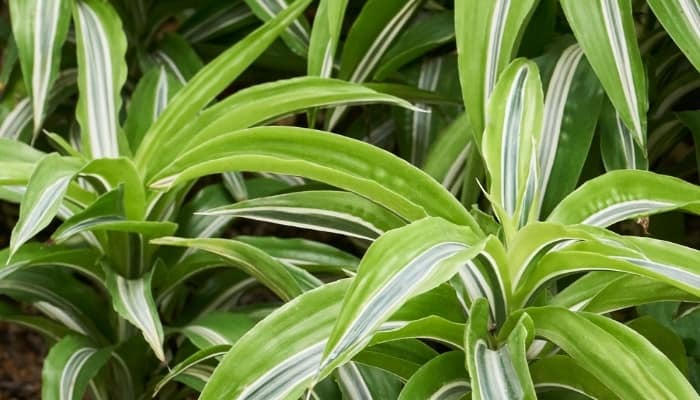Bred from the Dracaena fragrans plant, also known as the corn plant, Dracaena ‘Warneckii’ is easily identified by its elegant, sword-shaped leaves with a combination of green and creamy white stripes.
It’s a popular fixture of office buildings the world over or your home with the right care!
How do you care for Dracaena ‘Warneckii’? Dracaena ‘Warneckii’ plants require a loose, airy soil medium and light watering to thrive as excess moisture is the main cause of foliage and root issues. It also performs best in a tropical climate of moderate-high temperatures and humidity.
Caring for Dracaena ‘Warneckii’: Basic Guidelines
Warneckiis take around 10 years to reach maximum height, making them elegant tabletop plants or towering floor statements depending on your devotion.
From propagation technique and ideal conditions to pest troubleshooting, we’ve outlined what it takes to give this low-maintenance stunner the care it deserves.
Complete Care Guide for Dracaena ‘Warneckii’
With its genus name Dracaena meaning female dragon in Ancient Greek, ‘Warneckii’ family origins date back to 23 A.D.
It would take until the late 1800s for Dracaenas and their cultivars to become widespread following European botanists’ expeditions to deepest Africa and Asia.
Today, the ‘Warneckii’ variety is both a workplace and household favorite and was even awarded the Royal Horticultural Society’s award of Garden Merit in 2002.
Dracaena ‘Warneckii’ at a Glance
- Plant Type: Evergreen shrub
- Scientific Name: Dracaena fragrans ‘Warneckii’
- Average Height: 5 feet (1.5 m)
- Average Width: 30 inches (75 cm)
- Growth Rate: Slow
- Produces Flowers: Yes
- Common Pests: Spider mites, mealybugs
- Life Expectancy: 15-20 years
- Difficulty of Care: Low
Ideal Soil for Dracaena ‘Warneckii’
Loose, airy soil will help your Warneckii thrive as it is drought-tolerant and in need of a medium that won’t retain much moisture.
Avid gardener and co-creator of the Desert Succulents blog Joseph Spencer recommends mixing:
“1/3 peat moss, 1/3 pine bark and 1/3 coarse builder’s sand to provide a gritty, well-draining texture.”
Dracaena ‘Warneckii’ Water Requirements
Feel halfway down into the pot to check that your soil medium has dried before watering, as perpetually moist soil can promote root rot.
Aim to water every 1-2 weeks depending on the soil’s feel, and use distilled water as Dracaena plants have a sensitivity to fluoride from tap water.
Dracaena ‘Warneckii’ Lighting Needs
Warneckiis enjoy moderate-bright indirect light, coping well in low-lit areas, which is why they thrive so well under fluorescent office lighting.
Note that its variegated leaves contain less chlorophyll than solid-green plants, so growth can suffer in very dim locations.
Place them a few feet from a south-facing window to let them bask in filtered, afternoon sun.
Ideal Temperature and Humidity Range for Dracaena ‘Warneckii’
Temperatures of 65-80°F (18-26°C) are perfect for this African-native plant, and typical room humidity levels of 40-60% will be ideal.
Just be sure not to let temperatures drop below 50°F (10°C) for long periods, and prevent fluctuations by shielding it from heat vents, drafts, and ACs.
Occasional misting and other humidity measures will benefit Warneckiis kept in drier homes.
Best Location for Dracaena ‘Warneckii’
Bathrooms are great for providing your ‘Warneckii’ plant with daily bursts of tropical humidity, though these fairly hardy plants can tolerate most locations that maintain the aforementioned environment.
Dracaena ‘Warneckii’ Growth Habits
The ‘Warneckii’ has an erect growth habit of a central trunk with branches of bushy foliage. Some varieties are multi-stemmed to create a tiered tree-like effect.
Fertilization Type & Schedule for Dracaena ‘Warneckii’
As light feeders, your ‘Warneckii’ plant will only need fertilizing once monthly during its spring-fall growing season.
Plant hobbyist Phil over at Soil, Seed, and Garden recommends: “balanced liquid fertilizer diluted to 50% strength and be sure to feed while watering to prevent burning the dry soil.”
Signs of Nutrient Deficiency
Yellow spotting and brown tips on the foliage are typical signs of nutrient deficiency due to under-watering, so be sure to check the potting soil weekly with your fingers to ensure it doesn’t remain dry for long periods.
Also watch out for crispy, browning foliage as this can be caused by over-fertilizing or using chemical-laden tap water, so opt for purified water where possible.
Pruning Dracaena ‘Warneckii’
Stalks/canes with a sparse amount of leaves can be cut back using sharp, clean pruning shears.
You should remove excessively yellow or dying leaves to encourage healthier growth and reduce debris.
Does Dracaena ‘Warneckii’ Produce Flowers?
While rare indoors, Warneckiis can produce subtle globular creamy yellow blooms in summer when grown in perfect tropical conditions outdoors (USDA Hardiness Zones 9-12).
Is Dracaena ‘Warneckii’ Toxic?
Though nontoxic to humans, the saponins in all Dracaena plants are mildly toxic to pets when ingested causing lethargy and gastrointestinal issues among other symptoms.
Dracaena ‘Warneckii’ Propagation
You may decide to grow offspring plants from your Dracaena ‘Warneckii’ by propagating it, and the best way to do this is by taking stem cuttings from the central cane and replanting them:
1. Take 8-12 Inch Healthy Stem Cuttings & Place in Jars of Water
Cut 8-12 inch stem cuttings growing from the main cane using sterilized pruning shears.
Founder of The Plant Shanty Katie Emory advises cutting at “a 45° angle to maximize the surface the roots can grow from.”
Next, dip the cutting ends in rooting hormone (this one works well for me) to speed up growth before placing each cutting into a 1 liter jar/container of distilled water.
2. Replace Water Weekly & Wait 3-4 Weeks for Roots
Change the jar water weekly to keep rot at bay, and allow at least 3 weeks for the stem cuttings to start developing roots.
“Look for white nodules forming at the base and allow them to measure at least 3cm” advises self-confessed houseplant nerd Erica Puisis of Diys.com.
3. Prepare New Pots, Plant Rooted Cuttings & Water Well
Prepare small plant pots for your stem cuttings (5-6 inches is a good starter size) by filling each halfway with the ideal potting mix to give them a nutrient-rich home.
Place each cutting in the center of a pot. Pour in additional soil and lightly pat around the top to secure it in place.
Give each baby ‘Warneckii’ a thorough watering, allow it to drain fully, and place each in an appropriately humid, well-lit area.
Look for healthy new green shoots appearing through the soil after a few weeks.
Repotting Dracaena ‘Warneckii’
After a few years in the same size pot and same old soil, your slow-growing ‘Warneckii’ plant will appreciate being rehomed to spread its roots and continue to grow tall and happy.
When To Repot Dracaena ‘Warneckii’
Repotting is needed every 3 years as the plant outgrows its current container. As the roots expand in the soil, they’ll begin breaking up the medium, creating a far looser consistency.
You’ll also notice your Warneckii’s roots bursting through the pot’s drainage holes in its bid to escape the cramped conditions.
Signs That It’s Time To Repot
- Soil appears looser than usual
- Roots protruding through drainage holes
How To Repot Dracaena ‘Warneckii’
1. Water the Day Before Repotting & Prepare a Pot 2 Inches Larger
Houseplant influencer and UK Houseplants curator Joe Bagley advises hydrating your ‘Warneckii’ plant “24 hours before repotting to help it overcome transplant shock.”
Helpfully a moist soil base will make removal far easier too. In the meantime, fill a new pot (2 inches larger in diameter than your existing container) halfway with fresh potting mix.
2. Gently Slide the Plant Out, Remove Old Soil & Check Root Health
Steadily remove your ‘Warneckii’ from its current pot, and carefully break apart the old soil to expose the root ball system.
Before repotting check that you have healthy roots – they should be pale in color and feel firm (not mushy or black).
The latter will mean root rot, so cut off any diseased sections with a sharp, sterilized knife.
If the rot is widespread, the mother plant will sadly need discarding, though propagation via stem cutting is an option.
3. Re-plant Warneckii in New Pot & Water Thoroughly
Place the plant in its new pot of soil, positioning the root ball below the rim and as centrally as possible before filling with fresh potting mix and pressing down the soil surface to secure the roots.
Soak the soil of your newly repotted Warneckii to help it settle, and make sure that it is draining well.
Dracaena ‘Warneckii’ Common Problems & Solutions That Work
Dracaena ‘Warneckii’ Common Pests
Thankfully this super hardy houseplant isn’t troubled by many pests, though these are the ones to watch out for – and they’re easily managed under the right conditions:
Spider Mites
-
Signs of Trouble – Small brown or yellow spots on the undersides of leaves.
-
Solution – Kill clusters on-site with a strong stream of water. Spritz the area with organic insecticidal soap solution.
-
Prevention – Clean the leaves with a damp cloth once weekly, and avoid overwatering.
Mealybugs
-
Signs of Trouble – Sticky residue on leaves, white cotton wool-like clusters on foliage undersides, and cubby holes at the base.
-
Solution – Clusters are easily removed by hand or washed off with water spray.
-
Prevention – Spray commonly affected areas with neem oil (a natural seed oil that paralyzes a mealybugs nervous system), and avoid future outbreaks by sticking to the ideal temp/humidity range.
Dracaena ‘Warneckii’ Common Diseases
Overly moist, warm conditions are sure to encourage fungal conditions, so take care not to overwater your ‘Warneckii’ to avoid running into these issues:
Fusarium (Leaf Spot Disease)
-
Signs of Trouble – Reddish/brown spots in yellow halos at base of leaves.
-
Solution – Prune affected leaves with sterilized shears.
-
Prevention – Move plant to a spot with better air circulation, reduce watering, and apply fungicide (this copper fungicide really works well) to healthy leaves to prevent further spores.
Root Rot
-
Signs of Trouble – Stunted growth, yellowing leaves, and dark root patches.
-
Solution – Trim diseased foliage and root sections; propagate healthy stems if root rot is widespread.
-
Prevention – Allow soil to dry in between watering, and add pine/orchid bark to increase aeration.
Other Common Problems
It may tolerate some neglect, but dismissing your Warneckii’s regular needs will create foliage issues sooner or later. Spot the following issues early to sidestep serious damage:
Browning Foliage
-
Signs of Trouble – Brown tips or leaf edges.
-
Solution – Prune discolored leaves with clean shears, and increase the relative humidity by changing locations or placing a pebble tray nearby (here’s how to make one).
-
Prevention – Ensure soil mix feels dry, not moist, before each watering and check that the mix drains properly.
Dropping Leaves
-
Signs of Trouble – Noticeable leaf loss, severely wilted foliage.
-
Solution – Move plant into better light, ensure soil mix drains well after watering.
-
Prevention – Maintain consistent temperatures by avoiding drafts, review your watering regimen.
Dracaena ‘Warneckii’ Common Questions

Should I Mist My Dracaena ‘Warneckii’?
In place of a humidifier, weekly misting can help dry homes achieve ideal humidity.
Misting more frequently than this is not advised since these plants are prone to leaf spot fungus. Use a humidity monitor to help you decide upon misting frequency.
How Long Do Dracaena Plants Live?
“It’s not unusual to see Dracaenas live to 30, even 40 years old due to their tolerance for neglect” shares former editor-in-chief of Houseplant Magazine and creator of the Laid-back Gardener blog Larry Hodgson.
How Do You Straighten a Dracaena ‘Warneckii’?
Rotate your plant so that the leaning portion is facing the brightest available sunlight.
You can also encourage upright growth by checking the central trunk is set tightly in the soil in a vertical position and ensuring all essential environmental needs are met.
3 Key Tips for Success With Dracaena ‘Warneckii’
1. Line the Pot With Lava Rocks for Increased Soil Aeration
The Plant Shanty founder, Katie Emory, swears by lining the bed of Dracaena plants with lava rock “to provide ultimate porosity, so the roots can breathe and spread.”
Lava rock guards against root rot too since excess water pools at the very base of the pot instead of being absorbed by the potting mix.
2. Get to Know Your Plant’s Preferred Watering Frequency
This plant can survive a forgetful waterer, but it will thrive with a watering pattern that predicts its needs.
Check the soil every day with your fingers to gauge how long it takes to go from moist to dry – you’ll quickly have an idea of its ideal watering schedule.
3. Opt for Slow-release Fertilizer for Gentler Care & Decent Growth
Regular monthly fertilizer is fine if you prefer faster growth, but a slow-release fertilizer can achieve decent growth and reduce the stresses on your plant from excessive use.
Oftentimes, a single application of slow-release feed can sustain your ‘Warneckii’ for the entire growing season!
Conclusion
In summary, Dracaena ‘Warneckii’ is a tolerant, easy-to-care-for houseplant that prefers light watering, loose soil, and a tropical environment to flourish.
Maintain its striking foliage by shielding it from direct sunlight and recognize when your potting mix is no longer serving the roots well to get the most out of this statement shrub.

Image credit: Yanyan Acquiapat Titiwa
Sources:
https://www.newprocontainers.com/blog/plant-profile-dracaena-genus/
https://wagwalking.com/condition/warneckii-dracaena-poisoning
https://soilseedandgarden.com/dracaena-warneckii/
https://www.houseplant411.com/houseplant/dracaena-warnekii-how-to-grow-care-guide-striped-dracaena
https://hortology.co.uk/products/dracaena-deremensis-warneckii-multi-stem
https://desertsucculents.com/warneckii-dracaena-fragrans-details-growing-tips/
https://www.diys.com/dracaena-warneckii/
https://www.ukhouseplants.com/plants/dracaena-deremensis-group
https://indoorgardenook.com/dracaena-types/
https://www.gardeningknowhow.com/houseplants/dracaena/dracaena-pest-control.htm
https://extension.psu.edu/dracaena-diseases
https://bloomscape.com/common-issue/why-are-the-tips-on-my-dracaena-turning-brown/
https://gardenforindoor.com/dracaena-leaves-falling-off/
https://www.mygardenlife.com/plant-library/2409/dracaena/deremensis/warneckii
https://laidbackgardener.blog/2017/01/11/when-a-corn-plant-blooms/
https://garden.org/thread/view/110738/Dracaena-Warneckii-Leaning-Approx-6-month-old/
https://theplantshanty.com/blogs/plant-care-guides/dracaena-care-guide

